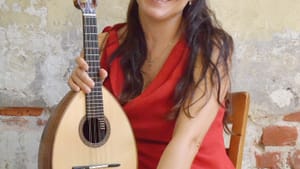Stay in the Loop
BSR publishes on a weekly schedule, with an email newsletter every Wednesday and Thursday morning. There’s no paywall, and subscribing is always free.
A marvelous mandolin
The Chamber Orchestra of Philadelphia presents mandolinist Caterina Lichtenberg

If you think a mandolin is a pricey device for slicing vegetables, think again. It’s an almost forgotten instrument that once commanded the attention of composers such as Vivaldi, Hummel, and Beethoven and traces its roots back to the minstrels of the Middle Ages—and the Chamber Orchestra of Philadelphia isn’t going to let it go.
In February, the orchestra brought this whimsical but highly expressive instrument into the heart of its latest concert in a season series titled Migrations. This concert focused on the exchange of ideas through Europe during the 17th and 18th centuries; past concerts have taken listeners to Africa and Asia, and will progress through the Americas and Middle East through season’s end.
Enter the mandolin
Associate concertmaster Meichen Liao-Barnes led the ensemble, which ranged in forces from five to a dozen or so musicians on stage in the Perelman Theater. Throughout a program of seven works, she kept the pace alternately exciting and serene, and allowed the orchestra’s talented musicians freedom to follow their hearts.
After a cheerful overture by Telemann, and Bach’s familiar Air on the G String, the ensemble was joined by Caterina Lichtenberg, one of the world’s most accomplished mandolinists and professor of mandolin at the Music Conservatory of Cologne. Lichtenberg carried the small, lute-like instrument, about the size of a halved casaba melon, to center stage where she sat with first one, then both feet perched on a small stool.
The mandolin has four sets of two strings tuned in unison to perfect fifths and is played with a plectrum (pick). Sustained tones are achieved by fluttering the pick across the strings, so the performer’s fingers are seldom idle.
Standout strings
Lichtenberg soloed in the Concerto in G for mandolin by Domenico Gaudioso, an 18th-century composer known primarily for this composition. Gaudioso reportedly lived in Naples during the time of some major mandolin innovations, such as switching from gut to metal strings. Lichtenberg used this bright metallic sound to good effect in counterpoint to the warm richness of the double-bass. Indeed, she explored an expressive and dynamic range that I do not recall hearing in other mandolin performances. Following a lyrical second movement, the work concluded with a complex finale that meandered back and forth between major and minor.
Lichtenberg next performed Gabriele Leone’s Air No. 4 for mandolin solo, a haunting voyage through a kind of musical Marrakesh: spicy, veiled, and mysterious. Lichtenberg suffused her performance with an aura of subtlety and warmth one doesn’t usually associate with this plucky instrument.
A lengthy sermon
The soloist left the stage for the longest selection on the program, Antonio Caldara’s Sinfonie a Quattro, four of his Sinfonie (much like concert overtures) for small orchestra. While one of the most prolific of Baroque composers, Caldara (1670-1736) is not often performed today, making an occasional appearance in Baroque ensembles, choral groups, and in lute or guitar recitals. However, the complete set of 12 Sinfonie on religious themes, encompassing 40 movements, is a remarkable achievement with great musical variety well worth hearing and enjoying.
In this performance, though, it was difficult to tell from the program notes just how many movements were being performed. Four of the 12 Sinfonie were listed and played, for which I counted a total of 14 movements, though I wouldn’t be surprised if I was off by a few—no doubt many listeners were also confused. Even with a thorough rereading of the program notes, the Sinfonie sometimes seemed like a preacher’s sermon that keeps promising to end, only to rise up and move on afresh to a new topic.
A musical force
Lichtenberg returned to join a scaled-back orchestra in Vivaldi’s popular Concerto in D for mandolin, RV (Ryom-Verzeichnis) 93. This spritely concerto, with its second movement redolent with sweet longing, offers a wide-ranging palette of colors and effects. Through this and her other intriguing selections in this concert, Lichtenberg demonstrated that the mandolin is a musical force to be taken seriously and with great pleasure.
The concert ended with Ettore Pinelli’s (1843-1915) charming little suite based on the musical ideas of Arcangelo Corelli (1653-1713). Most classical fans know Corelli’s name well enough, but how many of us have heard much beyond the Christmas Concerto and a few trio sonatas? We should hear more of his distinctive style and recognizable voice. The Pinelli miniature is an entertaining example of Victorian pseudo-Baroque, but no substitute for the real thing.
Under music director Dirk Brossé, the Chamber Orchestra will be back with more “Migrations” this spring, focusing on the Americas (March 31 and April 1) and the Middle East (May 19 and 20).
What, When, Where
Migrations: Europe. Georg Philipp Telemann, Overture from Suite in G Minor; Johann Sebastian Bach, Air on the G String; Domenico Gaudioso, Concerto for Mandolin; Gabriele Leone, Air No. 4; Antonio Caldara, Sinfonie a Quattro (Nos. 1, 8, 9, and 10); Antonio Vivaldi, Concerto in D for Mandolin, RV 93; Arcangelo Corelli (arr. Ettore Pinelli), Suite for String Orchestra. Orchestra led by Meichen Liao-Barnes. Caterina Lichtenberg, mandolin. The Chamber Orchestra of Philadelphia. February 24 and 25, 2019, at the Kimmel’s Perelman Theater, 300 S. Broad Street, Philadelphia. (215) 545-5451 or chamberorchestra.org.
Sign up for our newsletter
All of the week's new articles, all in one place. Sign up for the free weekly BSR newsletters, and don't miss a conversation.

 Linda Holt
Linda Holt